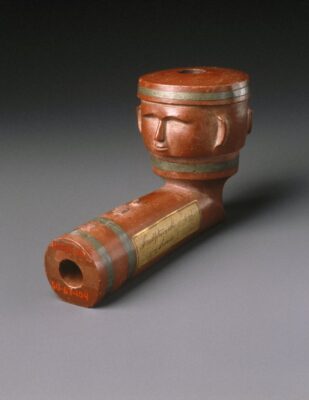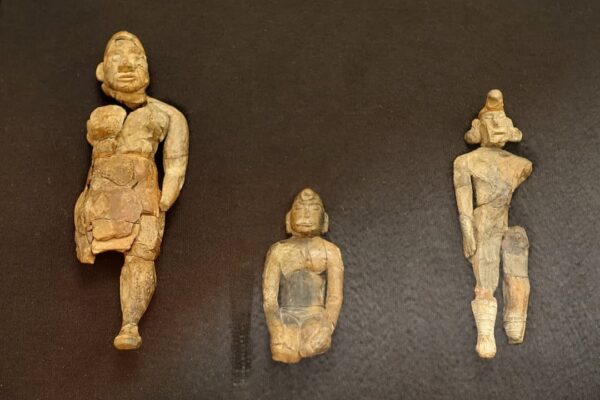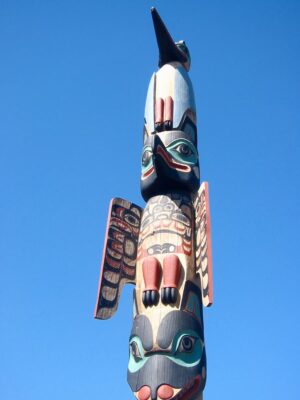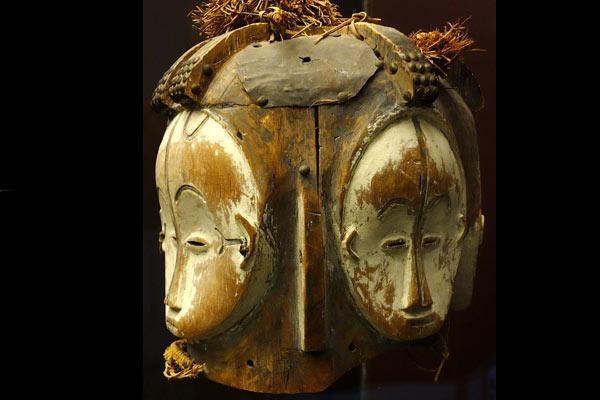Native North American Art
Land of the Thunderbird
“It is very misleading to refer to [American] Indian art as primitive art. The word primitive, in either its literal sense, describing an early stage of development, or its popular sense, implying lack of refinement, only fits certain of the rudimentary and archaic forms of Indian art which can hardly be considered representative. Most Indian art is the result of a long period of development in which capable craftsmen devoted all their inventive skill to perfecting specialized techniques and styles.”
Frederic H. Douglas and Rene d’Harnoncourt, “Indian art of the United States”, 1941
Images: Sioux, Pipe Bowl with Two Faces, early 19th century. Brooklyn Museum ·· Figurines, Hopewell culture, Ohio, 200 BC to 500 AD. Peabody Museum ·· Tlingit totem pole, Alaska. Photo by KenWalker
The art of the native peoples of North America is usually studied in a separate chapter from the art of Mesoamerica and South America (Pre-Columbian art), not so much because of the geographical separation but because of the historical context related to the arrival of the European conquerors. While in the areas that were taken over by the Spaniards and Portuguese, mestizaje between natives and Europeans was extensive, that was not the case of North America, taken over mainly by the English, French and Dutch,wherethe native peoples were either massacred or, on many occasions, expelled from their lands and concentrated in small areas. This -together with the fact that the conquest of North America took place later than that of Mesoamerica and South America, especially in the northern regions- means that several Native American cultures have been able to survive (albeit extremely reduced) to the present day, while the Mesoamerican and South American civilisations “disappeared” with the mestizaje.
In the hot, dry lands of what is now California and the American West, several cultures adapted well to the climate of the region. The Anasazi, from whom the Pueblo Indians are descended, are well known for their cliff dwellings and mastered pottery and textiles, while the Chumash are noted for their basketry and cave paintings. In the Great Plains area, several tribes persist (Sioux, Kiowa) who mastered the art of textile painting. The Woodlands east of the Mississippi were inhabited by several cultures who had the common characteristic of building large burial mounds, and are collectively known as Mound Builders. Prominent among these is the art (usually small sculptures) of the Hopewell Culture, a culture described as “a brilliant florescence of art, architecture, ceremony, and interregional interaction that was unparalleled in North America up to that time” (Bradley T. Lepper, “Archaeology of the Hopewell Culture”, 2017).
In any case, the most interesting works of art produced by the native peoples of North America are those created on the Northwest Coast, from what are now the states of Washington and Oregon to Alaska. These cultures (Haida, Tlingit, Tsimshian, or Kwakwaka’wakw) are well known for their wooden totem poles, which often include carved faces and forms of legendary creatures such as the Thunderbird, a style that carries over into other works such as masks and canoe prows. Masks are also a fundamental part of the art of the Inuit (sometimes called Eskimo, although this term is sometimes considered offensive) of northern Alaska and the Arctic areas.
G. Fernández · theartwolf.com
Follow us on:





